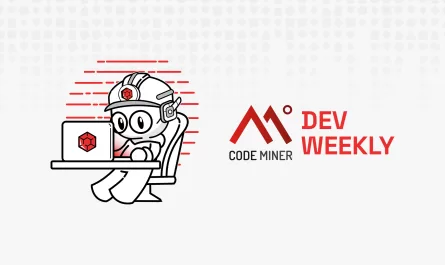HELLO EVERYONE!!! It’s the 23rd of August of 2024 and you are reading the 25th edition of the Codeminer42’s tech news report. Let’s check out what the tech world showed us this week!
LiveState for Elixir: An Overview and How to Build Embeddable Web Apps – by Pulkit Goyal
LiveView enhances the development experience in Phoenix by managing all states on the server, simplifying client-server coordination. LiveState seeks to replicate this streamlined process for embeddable web apps. Before exploring LiveState further, it’s important to define what embeddable web apps are. Check it out!
How to Read and Write Files with Node.js – by Ashutosh Krishna
Ashutosh Krishna’s tutorial on Node.js focuses on the fs module, which is essential for file operations in applications. It covers importing the fs module, reading and writing files, asynchronous and synchronous methods, and much more. He also demonstrates how to read text, HTML, and JSON, as well as fetch files from URLs using the https module.
Unlocking the Power of React 19: Grasp the New ‘use’ API – by Vishal Yadav
React 19 introduces the use API, simplifying data fetching in React components. It eliminates state management and boilerplate code. The API works with React’s Suspense feature, managing loading states and re-rendering components. We developers should use it judiciously, avoiding overuse and performance pitfalls. Check out this useful React feature.
Why Infastructure-as-Code is NOT the right tool to configure IAM? – by Nic Vermande
The article discusses why Infrastructure-as-Code (IaC) is not enough for Identity and Access Management (IAM) because of its static nature, absence of security best practices, and complexity. It suggests utilizing Otterize, an open-source tool for IAM in cloud-native environments. Otterize automates policy management, ensures dynamic access control, and addresses security compliance. Check it out!
Pinterest Modernises Machine Learning Infrastructure with Ray – by Matt Saunders
Pinterest and DoorDash have integrated Ray, an open-source distributed computing framework, into their machine-learning infrastructure to improve business problem-solving. The custom solution includes an API Gateway with a dedicated user interface. The utilization of Ray has reduced production time from weeks to days, highlighting the flexibility and efficiency of this framework in handling large-scale tasks. Take a look to learn more about the usage of this interesting framework.
Anatomy of an Attack – by Jonathan Harper
The Hacker News article discusses the sophistication of cyber attacks, using Log4Shell vulnerability as an example. It highlights the limitations of traditional security measures like Web Application Firewalls and Endpoint Detection and Response systems. Application Detection and Response (ADR) technology offers deeper insights into application behavior, enabling more accurate threat detection and response. It advocates for organizations to invest in ADR as a strategic imperative to safeguard digital assets against evolving threats.
Rails 7.2 brings SQL queries count to template rendering logs – by Navaneeth D
In this article, the author, Navaneeth explains how Rails developers often face the challenge of debugging database queries, particularly with issues like the N+1 query problem and caching strategies. Traditionally, this required tedious manual inspection of logs to count SQL queries, which could be error-prone. However, Rails 7.2 improves this process by enhancing log output to include a query count in the ActiveRecord section, thus allowing developers to quickly identify the number of executed queries and assess caching effectiveness, ultimately saving time and aiding in optimization efforts.
Node releases version 22.7.0
Node.js now supports TypeScript syntax such as Enum and namespace through the new flag --experimental-transform-types. Module syntax detection is now enabled by default, allowing Node.js to run ambiguous files as CommonJS if they fail to parse due to ES module syntax. This feature has no performance impact on CommonJS modules but incurs a slight performance penalty for ES modules. Performance improvements to Node.js buffers have been made through multiple PRs, with significant improvements to the Buffer.copy and Buffer.write methods.
Data Modeling Entitlements and Pricing for SaaS – by Garrett Dimon
The author Garrett Dimon explains how and why Flipper Cloud is implementing updates to its pricing to move from seat-based to fixed-price monthly and yearly plans. The company aims to provide a better billing experience for customers by offering multiple sets of pricing and entitlements. The company has designed first-class support for multiple types of billing indefinitely, ensuring that existing customers don’t have to change plans just because they have new plans. The company has also refactored with a vision for supporting legacy pricing in parallel with the new approach.
—
And that’s all for this week! Wish you all a great weekend and happy coding!
We want to work with you. Check out our Services page!



